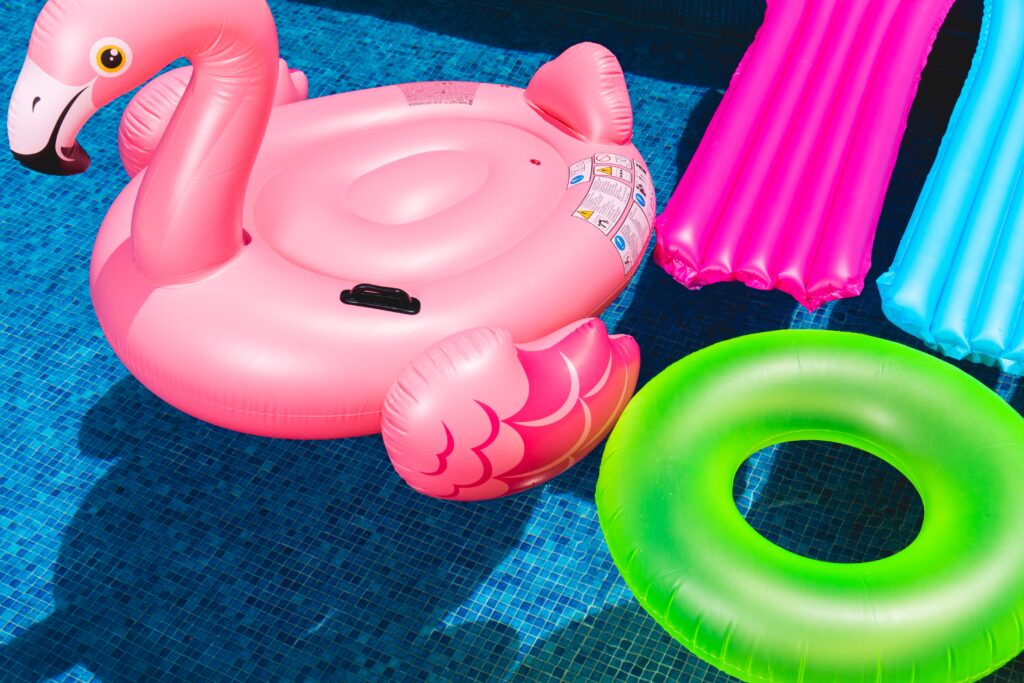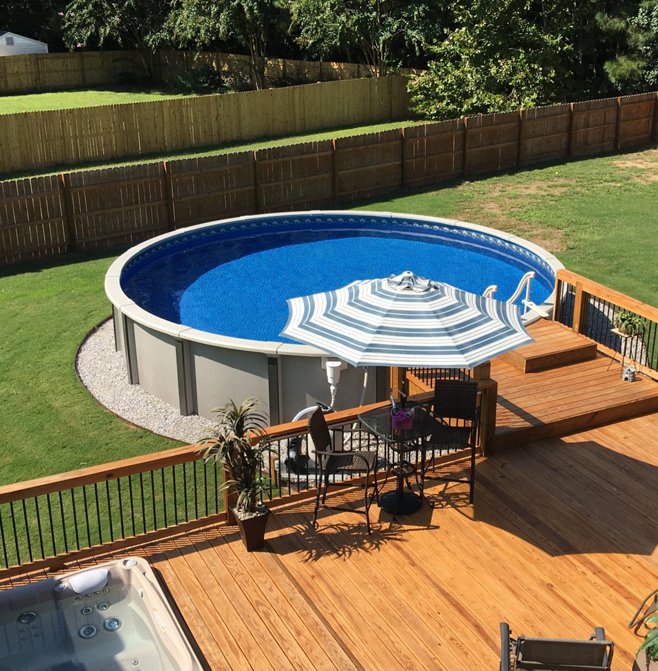If you have an above ground pool, you may find yourself wondering whether or not you should cover it every day. While the answer may vary depending on individual circumstances, there are some key factors to consider when deciding whether or not to cover your pool daily. This article will explore the benefits and drawbacks of covering your above ground pool on a daily basis, helping you make an informed decision that suits your needs and preferences.
This image is property of images.unsplash.com.
Benefits of Covering an Above Ground Pool
Prevents debris from entering the pool
Covering an above ground pool provides a barrier that prevents debris such as leaves, twigs, and insects from entering the water. These contaminants can easily accumulate and make it difficult to maintain clean and clear pool water. By keeping the pool covered when not in use, you can significantly reduce the amount of time and effort spent on cleaning, skimming, and vacuuming the pool.
Reduces evaporation of water
One of the main benefits of covering an above ground pool is the reduction in water evaporation. Without a cover, the pool can lose a substantial amount of water due to evaporation, especially during hot and dry weather conditions. By keeping the pool covered, you can minimize evaporation and save on water usage, which is not only cost-effective but also environmentally friendly.
Helps retain heat
Covering an above ground pool can help retain the heat generated by the sun or other heating systems. The cover acts as an insulating layer that prevents heat loss, especially during cooler evenings or windy days. This can significantly extend the swimming season by keeping the water at a comfortable temperature, allowing you and your family to enjoy the pool for a longer period of time.
Reduces chemical use
When an above ground pool is left uncovered, the sunlight can cause the breakdown of chlorine and other pool chemicals. This leads to a faster dissipation of chemicals, requiring you to add them more frequently to maintain proper balance and sanitization. By covering the pool, you can protect the water from direct sunlight, thus reducing the amount of chemicals needed to keep the water clean and safe for swimming. This not only saves you money on chemical expenses but also reduces the overall chemical exposure for swimmers.
Factors to Consider
Weather conditions
The weather conditions in your area play a crucial role in determining whether or not you should cover your above ground pool. If you live in a region with frequent rain, wind, or storms, a pool cover becomes essential to protect the pool from debris, excess water, and potential damage caused by strong winds. On the other hand, if you reside in an area with consistently mild and stable weather, the need for a cover might be less urgent.
Usage frequency
Consider how frequently you and your family use the pool. If you use it regularly, covering and uncovering the pool every day may seem impractical. However, if the pool is primarily used on weekends or special occasions, it’s advisable to cover it during periods of non-usage to keep it clean and reduce maintenance efforts.
Cost and convenience
Covering an above ground pool involves some financial investment, so it’s important to consider the cost of purchasing and maintaining a pool cover. Additionally, you should think about the convenience factor. Some covers, such as automatic or safety covers, provide ease of use and can be operated with minimal effort. Consider both the cost and convenience when deciding on the type of pool cover that best suits your needs.
Pool water temperature
If maintaining a specific water temperature is important to you, then covering your above ground pool can help retain heat and prevent unnecessary heat loss. However, if the temperature of the pool water isn’t a significant concern, leaving the pool uncovered in warm weather conditions might suffice.
Pool location and surroundings
The location of your above ground pool and its surroundings should be taken into account when considering whether to cover it or not. If there are many trees or plants near the pool, covering it can help prevent debris from falling into the water. Similarly, if your pool is exposed to excessive dirt, leaves, or pollen, a cover can serve as a protective barrier, making pool maintenance much easier.
When to Cover the Pool
During periods of non-usage
When the pool is not in use for an extended period, such as during weekdays or vacations, it is recommended to cover it. This will help keep the pool water clean and minimize the need for frequent maintenance. By covering the pool during periods of non-usage, you can also reduce the risk of accidents, particularly if you have small children or pets.
During extreme weather conditions
When severe weather conditions such as heavy rain, strong winds, or storms are expected, it is crucial to cover your above ground pool. A pool cover provides protection against debris, excess water, and potential damage caused by extreme weather. By taking proactive measures and promptly covering the pool during such conditions, you can maintain the structural integrity of the pool and prolong its lifespan.
When the pool is not in use for an extended period
If you anticipate that the pool will not be used for an extended period, such as during the winter months, it is highly recommended to cover it. By doing so, you not only protect the pool from debris and weather elements but also reduce the risk of accidents and ensure the pool remains in good condition until the next swimming season.
At night to reduce heat loss
Covering the pool at night can help prevent heat loss, especially in cooler climates or during seasons with significant temperature fluctuations. As the air temperature drops, the water in the pool can lose heat rapidly. By covering the pool at night, you can retain the heat accumulated during the day and ensure the water remains at a comfortable temperature for swimming.
When Not to Cover the Pool
During active pool use
When the pool is actively being used for swimming, it is generally not necessary to cover it. However, if you take breaks or have extended periods of time without using the pool, it might be more practical to cover it during those intervals to preserve the water quality and reduce the amount of maintenance required.
During periods of consistent warm weather
If you live in a region with consistently warm weather, covering your above ground pool during these periods may not be necessary. The combination of warm temperatures and regular pool usage can result in higher evaporation rates, making it more convenient to keep the pool uncovered.
When sufficient chemicals have been added
If the pool water has been properly balanced and sufficient chemicals have been added, covering the pool may not be necessary from a chemical maintenance standpoint. However, it’s important to consider other factors, such as debris accumulation and the potential for heat loss, when deciding whether or not to cover the pool.
When pool water temperature is desired
If you prefer a cooler pool water temperature, leaving the pool uncovered during hot weather can help facilitate natural evaporation and cooling. This is particularly relevant in regions with extremely high temperatures or for individuals who enjoy swimming in cooler water conditions.
This image is property of images.unsplash.com.
Types of Pool Covers
Winter covers
Winter covers are specifically designed to protect the pool during the colder months when it’s not being used. These covers are typically made of durable materials and offer a high level of protection against debris, sunlight, and extreme weather conditions. Winter covers are typically secured tightly to the pool to provide maximum coverage and prevent the entry of unwanted contaminants.
Solar covers
Solar covers, also known as solar blankets, are designed to harness the power of the sun to heat the pool water. These covers are made of translucent or transparent materials that allow sunlight to penetrate and warm the water. Solar covers also help reduce evaporation and prevent debris from entering the pool.
Safety covers
Safety covers are primarily designed to ensure the safety of individuals, especially young children and pets. These covers are made of strong and durable materials that can support the weight of a person and act as a barrier to prevent accidental falls into the pool. Safety covers provide peace of mind and comply with safety regulations, making them a popular choice for families with children or pets.
Automatic covers
Automatic covers offer convenience and ease of use. With the press of a button or the turn of a key, these covers can be effortlessly operated, either opening or closing the pool. Automatic covers provide quick and efficient coverage, making them ideal for individuals who want a hassle-free pool cover solution.
Choosing the Right Pool Cover
Consider pool size and shape
When selecting a pool cover, it’s important to consider the size and shape of your above ground pool. Ensure that the cover you choose is specifically designed to fit your pool’s dimensions, taking into account any unique features or accessories. An ill-fitting cover may not provide the desired level of protection or perform as intended.
Determine your budget
Pool covers come in a range of prices, so it’s important to determine your budget before making a purchase. Consider the long-term cost of maintenance, as well as any additional features or accessories that may affect the overall price. Remember to balance your budget with the quality and durability of the cover to make an informed decision.
Evaluate durability and lifespan
It’s essential to select a pool cover that is durable and built to last. Look for covers made from high-quality materials that can withstand exposure to various weather conditions. A durable cover will provide effective protection and ensure longevity, saving you money in the long run.
Assess ease of installation/removal
Consider the ease of installation and removal when choosing a pool cover. Some covers, such as solar covers, are lightweight and easy to maneuver, while others may require additional assistance or specialized equipment. Choose a cover that is practical and user-friendly, especially if you plan on frequently covering and uncovering the pool.
Review additional features (solar-powered, safety mechanisms)
Certain pool covers come with additional features that can enhance their functionality and convenience. Solar-powered covers can aid in heating the pool water and reducing evaporation, while covers with safety mechanisms provide added protection and peace of mind. Review these additional features and determine their importance based on your specific needs and preferences.
This image is property of images.unsplash.com.
Maintaining the Pool Cover
Regular cleaning and debris removal
To ensure the effectiveness and longevity of your pool cover, regular cleaning and debris removal are essential. Use a soft brush or broom to remove leaves, dirt, and other debris from the cover’s surface. Avoid using sharp objects or abrasive materials that can damage the cover. Regularly cleaning the cover will prevent the accumulation of debris and maintain its functionality.
Proper storage during off-season
When the pool cover is not in use, proper storage is crucial to prolong its lifespan. Ensure that the cover is completely clean and dry before folding or rolling it up. Store the cover in a cool and dry location, away from direct sunlight or extreme temperatures. Following proper storage practices will help prevent damage and ensure that the cover is in good condition when needed again.
Repair or replace damaged covers
If you notice any tears, holes, or significant damage to the pool cover, it’s important to repair or replace it as soon as possible. Small rips can often be repaired using patch kits specifically designed for pool covers. However, if the damage is extensive or compromises the cover’s integrity, it’s advisable to invest in a new cover to ensure proper protection for your above ground pool.
Follow manufacturer’s instructions
Each pool cover may have specific instructions provided by the manufacturer. It is important to read and follow these instructions for proper installation, use, and maintenance. Following the manufacturer’s guidelines will help optimize the performance of the pool cover and ensure its longevity.
Tips for Covering an Above Ground Pool
Remove air pillows if using during winter
During the winter season, many pool owners use air pillows to help prevent ice damage by creating a barrier between the water and the pool cover. However, when covering an above ground pool with a winter cover, it’s important to remove the air pillows. Leaving the pillows underneath the cover can cause it to sag and collect water, potentially leading to damage or an increased risk of mold and mildew.
Use a pump to remove excess water
If you notice a buildup of water on the pool cover, it’s important to remove it promptly to prevent damage and maintain the cover’s functionality. Use a pool cover pump or a siphon to remove excess water, ensuring that the cover remains taut and properly sealed. Regularly monitoring and addressing water accumulation will help extend the life of your pool cover.
Secure the cover tightly to prevent wind damage
Strong winds can easily dislodge or damage a loosely secured pool cover. To prevent wind damage, ensure that the cover is tightly secured to the pool. Use ropes, bungee cords, or cover clips to secure the edges of the cover. Additionally, periodically check the cover’s tightness and make any necessary adjustments to avoid wind-related issues.
Consider using a cover support system for heavy snowfall areas
If you live in an area with heavy snowfall, using a cover support system can provide added protection and prevent the weight of snow from damaging the cover. These systems consist of a frame or inflatable tube that sits underneath the cover, creating a raised surface to prevent excess snow accumulation.
Monitor pool water chemistry regularly
Covering your above ground pool does not eliminate the need for regular water testing and chemical maintenance. Even with a cover, it is important to monitor the pool water chemistry regularly. Test the water at least once a week and adjust the chemical levels as necessary to ensure proper sanitization and a safe swimming environment.
Common Pool Cover Mistakes to Avoid
Not cleaning or removing debris before covering
Failing to clean or remove debris from the pool before covering it can lead to issues such as clogged drains, water contamination, and damage to the cover. Always take the time to thoroughly clean the pool and remove any debris before covering it to maintain water clarity and prevent potential damage.
Using damaged or ill-fitting covers
Using a damaged or ill-fitting pool cover can greatly reduce its effectiveness and potentially cause further damage. Inspect the cover regularly for tears, holes, or signs of wear and replace it if necessary. Additionally, ensure that the cover is specifically designed to fit your pool’s size and shape to provide optimal coverage and protection.
Failing to address water accumulation
Allowing water to accumulate on the pool cover can cause stretching, sagging, and potential damage to the cover. Regularly monitor and address any water accumulation by using a pool cover pump or siphon to remove the excess water. This will help maintain the integrity of the cover and prevent water-related issues.
Neglecting to check the cover periodically
Periodically inspecting the pool cover is important to identify any potential issues or damage. Check for tears, holes, or loose fastenings that may compromise the cover’s functionality. Timely detection of problems allows for prompt repair or replacement, ensuring that the pool remains protected and the cover performs optimally.
Improperly storing or folding the cover
Properly storing or folding the pool cover during the off-season is crucial to its lifespan and functionality. Improper storage can lead to creases, folds, or damage to the cover material. Follow the manufacturer’s instructions for folding or rolling the cover and store it in a cool and dry location to prevent any potential damage or deterioration.
Conclusion
When deciding whether or not to cover your above ground pool, it’s important to consider the specific benefits and factors outlined in this article. While covering the pool helps prevent debris, reduces evaporation, retains heat, and reduces chemical use, it’s essential to take into account weather conditions, usage frequency, cost and convenience, pool water temperature, and pool location and surroundings. By choosing the right pool cover for your needs, regularly maintaining it, and following recommended practices, you can enjoy a clean, well-protected, and enjoyable above ground pool experience.









